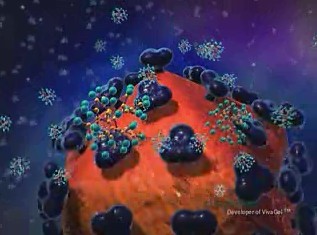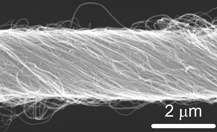Nano-Health, Nano-War
 Lots of nano-news over the past week or two -- and most of it good!
Lots of nano-news over the past week or two -- and most of it good!
Clean Bill of Health: One of the big questions about nanomaterials arising in recent months concerns the toxicity of nanoparticles, particularly carbon nanotubes. Since carbon nanotubes have applications ranging from solar power to artificial muscles (see below), their almost-magical potential would be blunted by confirmation of nasty effects on living tissues. Rice University is one of the leading institutions studying the biological effects of nanomaterials, so it was welcome news that a Rice University group (working with the University of Texas) has found through in-vivo tests that single-wall carbon nanotubes have no immediate harmful effects, and that they are flushed from the bloodstream within 24 hours -- long enough to be useful for medical procedures, but not long enough to trigger potential longer-term effects.
Obviously these tests need to be replicated and built upon, but still -- good news!
 Muscles Made of Yarn: One potential application in the body of carbon nanotubes may be in artificial muscle fibers. University of Texas at Dallas researchers have come up with a way to use carbon nanotubes, would together like yarn, as electro-chemical actuators acting essentially like muscles. According to Technology Review:
Muscles Made of Yarn: One potential application in the body of carbon nanotubes may be in artificial muscle fibers. University of Texas at Dallas researchers have come up with a way to use carbon nanotubes, would together like yarn, as electro-chemical actuators acting essentially like muscles. According to Technology Review:
By spinning carbon nanotubes into yarn a fraction of the width of a human hair, researchers have developed artificial muscles that exert 100 times the force, per area, of natural muscle. [...] The yarns are created by first growing densely packed nanotubes, each about 100 micrometers long. The carbon nanotubes are then gathered from a portion of this field and spun together into long, thin threads. The nanotube yarn can be just 2 percent of the width of a hair--not even visible--but upwards of a meter long.
There's still much work to do to make nanotube yarn a full replacement for muscles, but their potential is clear. Among the many issues surrounding powered prosthetic limbs and walking robots is the insufficiency of current artificial muscle/muscle replication technologies. At present, mechanical muscles are far weaker than biological muscles, gram-for-gram. If this line of research is successful, the situation may end up reversed.
Viva!: A biotech company with a comic-book name, StarPharma, has come up with a novel nano-material-based gel designed to block the activity of HIV and Herpes viruses. VivaGel™ is a "vaginal microbicide," made to be self-applied by women. It contains dendrimers -- synthetic polymer molecules shaped like the branches of a tree -- structured to stick to the linking surfaces on the virus in question, effectively making it impossible for the viruses to attach to the binding points on their cellular targets. The viruses can't harm the cells (or the host) because their molecular latches are clogged.
This kind of physical attack on a pathogen is less apt to result in the kind of rapid evolutionary adaptation that is seen with traditional antibiotic and antiviral medicines. The virus has to be able to connect to the right spot on a cell to take it over, so there's a very limited assortment of molecular structures it can have on its binding sites -- evolving away from the dendrimer being able to clog the site means evolving away from the site being able to link to the target cell. Adaption remains possible, of course, but just much less likely.
 Dendrimers are interesting molecules. Because of their branching structure, it's actually possible to design dendrimers that can target different viruses simultaneously. In principle, VivaGel™ could be an all-purpose viral STD blocker. StarPharma (not a wholly-owned operation of LexCorp) has begun safety trials with UC San Francisco.
Dendrimers are interesting molecules. Because of their branching structure, it's actually possible to design dendrimers that can target different viruses simultaneously. In principle, VivaGel™ could be an all-purpose viral STD blocker. StarPharma (not a wholly-owned operation of LexCorp) has begun safety trials with UC San Francisco.
Nano-War, Uh, What is it Nano-Good For? Moving away from nano-materials, fellow futurist Michael Anissimov spotted the publication of the academic work Military Nanotechnology, written by Dr. Jurgen Altmann. The book covers the application of nanomaterials as weapons, the use of nanoscale devices as sensors and the like, and the use of nanofabrication technologies to create novel systems. Altmann even looks at the policy implications of the use of human augmentation technologies for military purposes. The answers to how to respond to the development of these technologies won't come easily, but will be even harder to devise if we wait until the technologies are already available.
Unfortunately, as Michael notes, the people who need to take these issues seriously are likely to dismiss this as way off in the future, if they even give it that much thought.
Urgency Noted: That doesn't mean that nobody is paying attention. The National Materials Advisory Board has just released a congressionally-mandated review of US nanotechnology policy. Although it looks chiefly at policies around nano-materials and current research into nano-scale devices, it does take a few pages to consider some of the implications of nano-fabrication. My colleagues at the Center for Responsible Nanotechnology have studied the report in detail, and have offered their own take on its findings.
The Center for Responsible Nanotechnology (CRN) expects that the NMAB report will accelerate research toward the development of molecularly-precise manufacturing. However, without adequate understanding and preparation, exponential atom-by-atom construction of advanced products could have catastrophic results. Conclusions published in this report should create a new level of urgency in preparing for molecular manufacturing.
Most of the risks arising from all forms of nanotechnology are familiar, at least on their face. What nano-scale engineering, particularly molecular manufacturing, does is to make those risks happen much more swiftly, more cheaply, more easily, and in greater abundance. It's not that we don't know how to deal with toxic particles or readily-obtained weapons; it's that we've never lived in a world in which the particles could result from such a wide variety of common products, and the weapons could be so hard to detect and yet so powerful. Some of the risks associated with molecular technologies are novel, to be sure, but the core lesson we need to learn has less to do with how to respond to individual threats than with how to grapple with an environment in which the threats arise orders of magnitude more quickly than ever before.






Comments
Hazard needs evaluation not only in health adults but in old people and children and pregnant women. NASA recently documented the first evidence of single wall nano-tube causing asbestos like inflamation of the lungs on inhalation. THis is good news, yes, but anything other than a definitive absolution of risk.
Posted by: John Laumer | January 6, 2007 6:18 AM